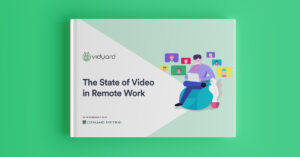We’re all on video more than ever before—whether we like it or not.
From video conferencing and webinar panels to shoot-and-share social videos and company productions starring employees, video is everywhere in today’s businesses.
If you’re camera shy, an introvert, or just plain uncomfortable on video, it can be a real nightmare. But it doesn’t have to be.
There are a few simple things you can do to get comfortable—and even feel confident—on camera.
Contents1. Understand Where Your Fear Comes From2. Know What You Want to Say3. Rehearse Your Message4. Choose Good Lighting5. Set Up Your Camera at a Flattering Angle6. Dress for Success7. Stage Your Background8. Keep a Glass of Water on Hand9. Talk Slower Than Usual10. Start with Screen Share Videos11. Be Expressive and Use Hand Gestures12. Don’t Worry About Little Mistakes13. Don’t Do a Million Takes14. Practice By Sending Videos to ‘Friendlies’15. Edit Your Own Videos16. Just Keep Making Videos
And you’ll be glad you did. Being comfortable on video isn’t just a useful skill for actors.
As we use video more across our professional and personal lives—from marketing and sales to internal communications and education—being on camera is increasingly something that everyone should know how to do, so we can all harness the power of video.

The State of Video in Remote Work
 Gain valuable insight into how businesses are using synchronous and asynchronous video while working remotely.
Gain valuable insight into how businesses are using synchronous and asynchronous video while working remotely.
Get the Report
1. Understand Where Your Fear Comes From
Before we begin, know this: You’re not alone. Feeling uncomfortable on video (and the underlying fears that feed it) are common. But that’s good news (yes, actually). It means tons of other people have successfully overcome their anxieties and you can too.
The first step in getting over feeling uncomfortable on video is understanding why it scares you.
Feeling uncomfortable on video is the natural intersection of a few other common fears: Camera shyness, public speaking anxiety, and stage fright.
Camera shyness is about image. Public speaking anxiety is about voice. Stage fright is about action.
Video brings together all three: Image, voice, and action. It’s a perfect storm of social anxiety.
Having your image, voice, and actions recorded can shine a spotlight on the things you’re already self-conscious about. You might not like the way you look or the way you sound. It might highlight nervous ticks you didn’t know you had.
Knowing what part of being on video freaks you out will help you focus on steps to feel more comfortable in that area.
2. Know What You Want to Say
Filming yourself (or being filmed) is a lot less scary if you’re not coming up with what you want to say on the spot.
If you’re planning to record yourself, set aside a little time to determine what your message is. Plan out your main talking points. Make some notes.
If you’re going to be in a scripted video production, ask to see the script in advance to review and get to know your lines.
Regardless of the situation, it’s always going to be easier when you know what you want to say.
This isn’t about how you look—it’s about who you are and what you’re saying.
 Dieter JaspersB2B Creative Agency BBCHead of Digital Experience
Dieter JaspersB2B Creative Agency BBCHead of Digital Experience
3. Rehearse Your Message
Once you know what you want to say, practice it. Then practice it again.
If you’re nervous about being on camera, going through your message a few times—out loud—will help you prepare. That preparedness will lessen your anxiety.
Don’t worry about exact wording. Focus on knowing your message, not memorizing lines. That way, it won’t trip you up nearly as much if you forget something.
This will also prevent you from sounding like a robot who’s reading off a piece of paper sitting just off screen.
4. Choose Good Lighting
Lighting is another easy way to feel like you look your best on film.
The most flattering lighting is even and front-facing. That means you don’t want your primary light source to be above you.
An easy way to do this is set up facing a window. This should give you fairly even natural lighting. If a window is unavailable, set up a lamp or similar light source behind your screen (slightly above or off to the side works).
5. Set Up Your Camera at a Flattering Angle
Most people look best on camera when the camera is either at or slightly above their eyeline. Feeling confident that you look your very best on camera can lessen your nerves.
If you’re part of a video production, the producer will take care of this. It’s also easy to achieve on your own, if you’re recording yourself.
If you’re shooting on mobile, prop your phone up at the right height, making sure that you’ve got something to keep it from sliding (a mobile tripod makes this easy, but it’s not required to make it work).
If you’re shooting a webcam video, set your computer on a box, stack of books, or whatever’s handy to achieve the right angle.
Record Your Webcam
Easily record and share webcam videos.
6. Dress for Success
If you’re wondering how to be comfortable on video, think about what makes you comfortable in general.
Think about how you’d feel showing up to a fancy event wearing blue jeans. Probably a bit out of place, right? Wearing the “right” outfit tends to make people more comfortable in various situations and video’s no different.
Think about your audience and the purpose of your video and dress to that. If it’s a business presentation, dress as you would if you were speaking in front of a group. If it’s a one-to-one video for a colleague, then being a bit more casual might be appropriate.
Wear things that you’re comfortable in and make you feel confident. And don’t forget to dress like you. Choose outfits that reflect your authentic self in a given situation.
A couple of related things to keep in mind: Solid colors tend to record well, so choose those, when possible. Avoid all-white or all-black outfits as those can throw off white balance. Be careful with patterns—ones with small lines can create a distortion effect that looks weird on camera.
7. Stage Your Background
This step is all about making sure your background isn’t a distraction to you (or viewers).
If you’re not worried about there being something potentially embarrassing in the background of your video (say an unmade bed, if you’re working from home), it’ll be a lot easier to focus on your message.
Aim for an uncluttered background in which you retain a point of interest (a plant, for instance) that helps balance the shot and provide visual interest.
8. Keep a Glass of Water on Hand
Nerves can make your mouth go dry. Trying to talk when your mouth is dry is uncomfortable in-and-of-itself and could make you feel more nervous.
Combat that by having some water before you begin. Keep a glass on hand and, if you need to have a sip part way through, do so.
9. Talk Slower Than Usual
When we’re nervous, we have a tendency to speed up and talk quickly (likely thinking the faster we do this thing, the faster it’ll be done).
Do your best not to rush. You don’t have to hustle to get every thought out straight away. Try to speak a bit slower than you would normally. Make yourself pause between thoughts.
Forcing yourself to slow down a bit can also make you feel a bit calmer (oddly). It also conveys confidence to your viewer because you won’t give off that nervous energy that sometimes goes hand-in-hand with fast talking.
If it feels like the video is stretching on while you’re recording, remember that viewers can use speed controls to make it faster if they choose (another benefit of speaking a bit slower is that it allows for this possibility).
Plus, pausing between thoughts has the added benefit of making the video easier to edit (if needed). When you barely pause to draw breath, it can be quite difficult to find cut points. Make it easier on yourself (or your video editor) and strive to take things just a bit slower.
Video isn’t as hard as you may think. If you’re in sales or service and you’re already comfortable talking all day, all you have to do is turn on the camera. It’s actually a lot easier to be understood through video than it is through email or other forms of written communication.
 Guido BartolacciNew BreedManager of Acquisition and Strategy
Guido BartolacciNew BreedManager of Acquisition and Strategy
10. Start with Screen Share Videos
If seeing yourself on camera is part of what makes you anxious, then start with screen share videos. This will let you practice the audio portion of video making. (Doing voice-overs could also work.)
Then, when you’re a little more comfortable with that, try out a hybrid screen recording-webcam video. There are free tools, like Vidyard’s Chrome extension, that let you record your screen, but add a small webcam bubble that records your face.
This can reduce anxiety by making you feel like you’re not the focus of the video, just one part of it. Making these videos can help normalize seeing yourself recorded, making it a bit less scary.
Then, when you’re ready, you can ‘graduate’ up to a full-on video production.
Free Screen Recording
Easily record and share your screen.
11. Be Expressive and Use Hand Gestures
If you’ve ever stared down a lens and thought, “But what do I DO with my HANDS?!” this is for you. (And who hasn’t really?)
Think about the last time you had a conversation with a friend. When you talk to people, you change your facial expressions. You move your hands around to emphasize points. You use body language to help communicate your point.
And you typically do it all without thinking about it. But as soon as you see that lens, you freeze up. When you’re nervous, it can be tough to do things the way you naturally would. But that’s one of the best things you can do. Make “eye contact” with the lens, smile (if it’s appropriate), and use hand gestures.
These actions are part of what make us human and they make it easier for viewers to connect with us. It may feel a bit unnatural at first, but it’s really just relearning things you already do and getting comfortable with doing them in a new context.
12. Don’t Worry About Little Mistakes
Making a mistake is one of the biggest things people worry about when shooting videos, but it’s not as dire as it sometimes feels.
Small mistakes, like stumbling over a word or two, make you seem more human and can actually make people like you more.
It lends authenticity to your videos.
Keep your video conversational and natural. If you stammer, who cares? People love it when you’re your authentic self.
 Adam RatajHubSpotSales Manager Mid-Market
Adam RatajHubSpotSales Manager Mid-Market
13. Don’t Do a Million Takes
If you’re recording a video (rather than streaming live), it can be tempting to keep doing it again and again until you get it “right.”
It is absolutely okay to do a couple of takes. Think of the first attempt like a first pancake: It’s totally okay to toss it. It can let you get all your nerves out so that you feel calmer and more confident for your next take. (After all, you already did this and the world didn’t end, did it?)
Especially when you’re learning, doing a couple of takes is a totally normal part of the process. It gives you the chance to choose the one you’re most comfortable with. Plus, it’s added practice.
What you want to avoid is doing five, 10, or even 15 takes. Perfection is the enemy of done when it comes to video. Do a couple, choose the best and call it a day.
14. Practice By Sending Videos to ‘Friendlies’
Practicing is a great way to get used to anything (especially the stuff that scares you). A great way to practice your on-camera skills is making videos for an audience of one.
Choose someone—a family member, friend, or coworker—who you feel comfortable with. Think about who might be best suited to provide you helpful feedback in a gentle way.
Then, make videos just for that person. Do it as many times as it takes to start feeling just a bit less scary.
If making videos for an external audience is your ultimate goal (and the one that’s making you sweat), start out with an internal audience: Record asynchronous videos for your colleagues. They’ll likely be a receptive audience and, as a bonus, it’s a great way to communicate and collaborate with your team.
15. Edit Your Own Videos
Making videos that require a bit of editing (as opposed to quick, shoot-and-share recordings)?
Edit them yourself, advises Vidyard’s Social Media Manager Charlie Rogers. This will force you to get used to seeing yourself on video and make the idea of it a bit less scary.
16. Just Keep Making Videos
In the end, getting comfortable on camera is partially about getting over yourself. Basically, you have to try not to overthink it too much and then just keep doing it until it doesn’t feel weird (or, at least, less weird).
Create Free Video Messages
Easily record and share videos.
The post How to Be Comfortable on Video: 16 Fool-Proof Tips appeared first on Vidyard.
Read more: vidyard.com










